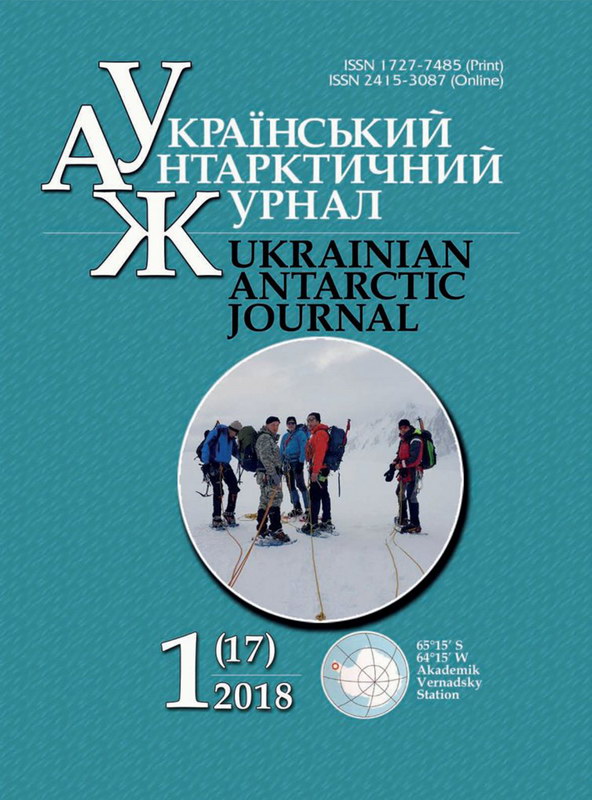Про можливість зондування границь північного аврорального овалу за реєстраціями високочастотних сигналів на наддалеких радіолініях
- іоносферна плазма,
- неоднорідності електронної концентрації,
- розсіювання ВЧ сигналів,
- полярна іоносфера,
- границя аврорального овалу

Ця робота ліцензується відповідно до Creative Commons Attribution-NonCommercial-NoDerivatives 4.0 International License.
Анотація
Мета. Розробка метода дослідження динаміки екваторіальної границі нічної сторони північного аврорального овалу за даними реєстрацій розсіяних сигналів на наддалекій радіолінії. Методи. Спектральний, часовий і частотно-часовий аналіз ВЧ сигналів станцій служби точного часу, що реєструються на Українській антарктичній станції (УАС) «Академік Вернадський». Виділення просторової моди сигналів, розсіяних на плазмових неоднорідностях високоширотної іоносфери північної півкулі. Розроблена методика ґрунтується на вимірюванні доплерівського зсуву частоти та часу групового запізнювання радіосигналу. Результати. За характеристиками розсіяних ВЧ сигналів станцій точного часу, зареєстрованих на УАС, представляється можливим вивчати динаміку екваторіальної границі нічної частини північного аврорального овалу. Висновки. При реєстрації ВЧ сигналів станції РВМ (55,75° пн. ш., 37,64° с. д.) на УАС (65,25° пд. ш., 64,27° з. д.) вдається виділити моду, розсіяну на неоднорідностях високоширотної іоносфери північної півкулі. Запропоновано методику діагностики екваторіальної границі аврорального овалу за даними спостережень на УАС розсіяних радіосигналів станцій служби точного часу. Використання таких станцій в якості джерел пробного випромінювання є досить зручним для діагностики іоносфери, оскільки вони мають ряд переваг, серед яких мала відносна частотна нестабільність задаючих генераторів; слабконаправлені антени та досить потужні передавачі, завдяки чому їх сигнали можна реєструвати в різних областях земної кулі; безперервна робота за заздалегідь відомим розкладом і, нарешті, той факт, що вони одночасно випромінюють на декількох частотах, що розширює можливості їх діагностичного використання. Даний підхід не вимагає додаткових передавальних пристроїв і дорогих антенних систем. Регулярні вимірювання за запропонованою схемою дозволяють вести моніторинг авроральної іоносфери, що згодом дасть можливість уточнювати існуючі моделі її поведінки.
Посилання
- Galushko, V. G., Zalizovski, A. V., Pikulik, I. I., Kascheev, S. B., Charkina, O. V. 2016. Pelengovanie VCh signalov, rasseyannyih ionosfernyimi neodnorodnostyami, spomoschyu malorazmernyih antenn [Direction finding of HF signals scattered by ionospheric irregularities using small size antenna]. Radiofizika i radioastronomiya [Radio Physics and Radio Astronomy], 21(3), 231-241. (Іn Russian). https://doi.org/10.15407/rpra21.03.231
- Zalizovski, A. V., Koloskov, A. V., Yampolski, Y. M. 2015. Issledovaniya v Antarktike chastotno-vremennyih harateristik VCh signalov na sverhdalnih radioliniyah [Studying in Antarctica the time-frequency characteristics of HF signals at the long radio paths]. Ukrainskij Antarktychnij Zhurnak [Ukrainian Antarctic Journal], 14, 124-137. (Іn Russian).
- Kascheev, S. B., Zalizovski, A. V., Sopin, A. A., Pikulik, I. I., 2013. O vozmozhnosti bistaticheskogo VCh zondirovaniya ionosfery i signalami tochnogo vremeni [On the possibility of bistatic HF ionospheric sounding by exact time signals]. Radiofizika i radioastronomiya [Radio Physics and Radio Astronomy], 18(1), 34-42. (Іn Russian).
- Koloskov, A. V., Yampolski, Y. M., Zalizovsky, A. V., Galushko, V. G., Kascheev, A. S., La Hoz, C., Brekke, A., Belyey, V.S., Rietveld, M. T. 2014. Set internet-upravlyaemyih VCh priemnikov dlya ionosfernyih issledovaniy [Network of Internet-controlled HF receivers for ionospheric researches]. Radiofizika i radioastronomiya [Radio Physics and Radio Astronomy], 19(4), 324-335. (Іn Russian). https://doi.org/10.15407/rpra19.04.324
- Starkov, G. V. 2000. Planetarnaya dinamika avroralnogo svecheniya [Planetary dynamics of auroral luminosity]. Fizika okolozemnogo kosmicheskogo prostranstva [Physics of the near-Earth space]. Polar Geophysical Institute, Kola Scientific Centre RAS, Apatity, 409-499. (Іn Russian).
- Borovsky, J. E. 1993. Auroral arc thicknesses as predicted by various theories. J. Geophys Res, 98, 6101-6138. https://doi.org/10.1029/92JA02242
- Frey, H. U. 2007. Localized aurora beyond the auroral oval. Rev. Geophys, 45, 1-32. https://doi.org/10.1029/2005RG000174
- Greenwald, R. A., Baker, K. B., Dudeney, J. R., Pinnock, M., Jones, T. B., Thomas, E. C., Villain, J.-P., Cerisier, J. C., Senior, C., Hanuise, C., Hunsucker, R. D., Sofko, G. J., Koehler, J. A., Nielsen, E., Pellinen, R., Walker, A. D. M., Sato, N., Yamagishi, H. 1995. DARN/SuperDARN: A global view of the dynamics of highlatitude convection. Space Sci. Rev., 71, 761-796. https://doi.org/10.1007/BF00751350
- Jayachandran, P. T., MacDougall, J. W., St-Maurice, J.-P., Moorcroft, D. R., Newell, P. T., Prikryl, P. 2002. Coincidence of the ion precipitation boundary with the HF E-region backscatter boundary in the dusk-midnight sector. Geophys.Res. Lett, 29(8). DOI:10.1029/2001GL014184. https://doi.org/10.1029/2001GL014184
- Newell, P. T., Feldstein, Y. I., Galperin, Y. I., Meng, C.-I. 1996. Morphology of nightside precipitation. J. Geophys. Res., 101(A5), 10,737-10,748. https://doi.org/10.1029/95JA03516
- Xiong, C.H., Luhr, H., Wang, H., Johnsen, M. G. 2014. Determining the boundaries of the auroral oval from CHAMP field-aligned currents signatures - Part 1. Ann Geophys, 32, 609-622. https://doi.org/10.5194/angeo-32-609-2014

